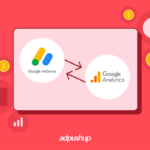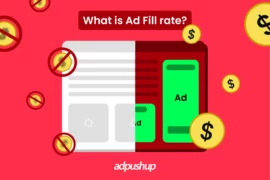In this post, we’ll look at programmatic ads vs display ads and try understanding what do these two terms mean for publishers, and which one publishers should use to optimize their online ads?
When it comes to online advertising, there are many ways to do it.
However, the most popular ways that are often used by advertisers are programmatic advertising and display advertising.
Ever since their advent, both programmatic and display ads have disrupted the advertising industry. They have been the talk of the town for so long now. But still, there are some people who are not that familiar with them.
Both have their own strengths and weaknesses. However, if you are new to them, it’s important to understand the differences between them to determine which one is the best fit for your business needs.
This guide will provide you a detailed insight on programmatic ads vs display ads.
Let’s get started by looking at what programmatic advertising is and how it works.
What is Programmatic Advertising?
Programmatic advertising is a type of digital advertising that uses technology to automate the buying and selling of ad inventory in real time. Rather than relying on manual negotiations and purchases, programmatic advertising uses algorithms and data to make ad buying more efficient and effective.
How Does Programmatic Advertising Work?
Programmatic advertising relies on a technology called a demand-side platform (DSP) to purchase ad inventory. A DSP is a software platform that allows advertisers to purchase ad space across a variety of websites and mobile apps.
Advertisers can set specific parameters for the audience they want to target, such as age, location, and interests.
Programmatic advertising also uses data to optimize ad performance. Advertisers can track how their ads are performing in real-time and make adjustments to improve their effectiveness. For example, if an ad is not performing well with a certain audience, the advertiser can adjust their targeting parameters to reach a more relevant audience.
Examples of Programmatic Advertising
Programmatic advertising can take many forms, including display ads, video ads, and native ads. Some common examples of programmatic advertising include:
- Retargeting Ads: These ads target users who have already interacted with a brand’s website or mobile app.
- Contextual Targeting Ads: These ads target users based on the content they are currently viewing.
- Behavioral Targeting Ads: These ads target users based on their previous online behavior, such as search history or browsing activity.
Check Here: 7 Best Examples of Programmatic Advertising That Needs Your Attention

What is Display Advertising?
Display advertising is a type of digital advertising that involves placing visual ads on websites and mobile apps. Display ads can take many forms, including banner ads, pop-up ads, and video ads.
These ads are designed to capture the attention of users and drive them to take a specific action, such as visiting a website or making a purchase.
How Does Display Advertising Work?
Display advertising works by purchasing ad space on websites and mobile apps that are relevant to a business’s target audience. Advertisers can choose the specific websites and apps where they want their ads to appear, as well as the size and placement of their ads.
Unlike programmatic advertising, display advertising does not use real-time bidding. Instead, advertisers negotiate directly with publishers to purchase ad space.
Advertisers can also use targeting parameters to reach their desired audience, such as demographic information and interests.
Examples of Display Advertising
Display advertising can take many forms, including banner ads, pop-up ads, and video ads. Some common examples of display advertising include:
- Banner Ads: These are rectangular ads that appear at the top, bottom, or sides of a website or mobile app.
- Pop-up Ads: These are ads that appear in a new window or tab, usually when a user clicks on a link or visits a new website.
- Video Ads: These are ads that appear before, during, or after a video on a website or mobile app.
Programmatic Ads vs Display Ads
Programmatic advertising and display advertising are two popular types of digital advertising, but they have some key differences. Here’s a breakdown of how these two advertising methods compare:
Targeting
The targeting capabilities of programmatic advertising are more precise than compared of display advertising. With programmatic advertising, advertisers can use a variety of data points to target their ads, such as browsing history, search behavior, and demographic information. Display advertising, on the other hand, typically relies on targeting parameters such as geographic location and interests.
Efficiency
When efficiency comes into play, programmatic advertising is on the brighter side. Since programmatic advertising uses automation and real-time bidding, advertisers can purchase ad inventory more quickly and at a lower cost than display advertising. Whereas display advertising requires manual negotiations with publishers and can be more time-consuming and expensive.
Performance
Programmatic advertising tends to have better performance than display advertising. Since programmatic advertising uses data and optimization to reach the most relevant audience, advertisers can see higher click-through rates (CTR) and conversion rates than display advertising. Display advertising, on the other hand, can be less targeted and may not perform as well.
Format
Programmatic advertising and display advertising can both take many forms, but display advertising tends to be more visual and attention-grabbing. Display ads can include images, videos, and animations, while programmatic ads are typically limited to text and images.
Cost
When it comes to cost, programmatic advertising and display advertising can both be cost-effective, but the cost can vary depending on the specific ad campaign and targeting parameters. Generally, programmatic advertising tends to be less expensive than display advertising due to its efficiency and real-time bidding capabilities.
Programmatic Ads vs Display Ads – Comparison Table
| Programmatic Advertising | Display Advertising | |
| Targeting | Uses real-time data and algorithms to target specific audiences based on demographics, interests, behavior, and more. | Targets a broad audience based on contextual relevance and placement on websites. |
| Ad Buying | Automated, using real-time bidding (RTB) and programmatic platforms. | Manual, usually through direct deals with publishers or ad networks. |
| Cost | Can be more expensive due to the use of advanced targeting and bidding strategies. | Generally less expensive due to broader targeting and less competition for ad space. |
| Management | Requires technical expertise to manage campaigns effectively. | Can be managed by a less technical team, but may not be as effective as programmatic advertising. |
| Ad Formats | Offers a wide range of ad formats, including display, video, native, and more. | Limited to display ad formats, such as banners, pop-ups, and interstitials. |
| Measurement and Optimization | Provides extensive data and analytics for optimizing campaigns in real time. | Limited data and analytics, making it more difficult to optimize campaigns effectively. |
| Ad Fraud | More susceptible to ad fraud due to the use of programmatic platforms and the complexity of the ad buying process. | Less susceptible to ad fraud, but still vulnerable to bots and invalid traffic. |
| Transparency | Offers greater transparency into ad placements, targeting, and performance metrics. | May lack transparency into ad placements and targeting, and may have limited performance metrics. |
| Real-time Optimization | Allows for real-time optimization of campaigns based on performance data. | May require manual adjustments and optimization based on limited performance data. |
| Brand Safety | Can be more effective at ensuring brand safety through the use of programmatic tools and targeting strategies. | May have limited brand safety measures in place, increasing the risk of ad placement on inappropriate or low-quality websites. |
| Frequency Capping | Allows for precise frequency capping to prevent overexposure to specific audiences. | May lack precise frequency capping, leading to ad fatigue and decreased campaign effectiveness. |
What Should You Choose – Programmatic Advertising or Display Advertising?
Advertisers can be offered be overwhelmed or confused while choosing between programmatic advertising and display advertising. However, here are a few key factors that can be considered:
Budget
One important factor to consider is your advertising budget. Programmatic advertising tends to be more cost-effective than display advertising, but it still requires a budget to be effective. Advertisers should consider their budget constraints when deciding which type of advertising to use.
Target Audience
Another important factor to consider is your target audience. If your target audience is specific and you have access to the data needed to target them effectively, programmatic advertising may be the better choice. If your target audience is more general or you are unsure of how to target them, display advertising may be a better fit.
Advertising Goals
Your advertising goals should also be taken into consideration when choosing between programmatic and display advertising. If your goal is to increase brand awareness or reach a large audience, display advertising may be the better choice. If your goal is to drive conversions or sales, programmatic advertising may be more effective.
Campaign Type
The type of campaign you are running can also influence which type of advertising is best for you. For example, if you are running a retargeting campaign to reach users who have already interacted with your brand, programmatic advertising may be the better choice. If you are running a holiday-themed display campaign to generate brand awareness, display advertising may be more appropriate.
Resources
Finally, consider the resources you have available to manage your advertising campaigns. Programmatic advertising requires more technical knowledge and resources to manage, while display advertising may be easier to manage with a smaller team.
Conclusion
Programmatic advertising and display advertising are both effective ways to reach your target audience online. However, they differ in their approach to targeting and buying ads, as well as their cost and level of technical expertise required to manage campaigns.
When deciding which type of advertising to use, it’s important to consider your advertising goals, target audience, budget, campaign type, and available resources.
Ultimately, the choice between programmatic advertising and display advertising will depend on your unique situation and goals.

Deepak has a keen eye for detail and a deep understanding of the ad tech landscape. Whether it’s through in-depth articles, thought-provoking insights, or compelling storytelling, he’s dedicated to helping people navigate the complex world of ad tech with the simplicity of his words.







